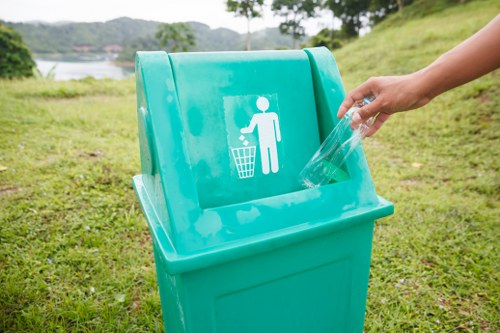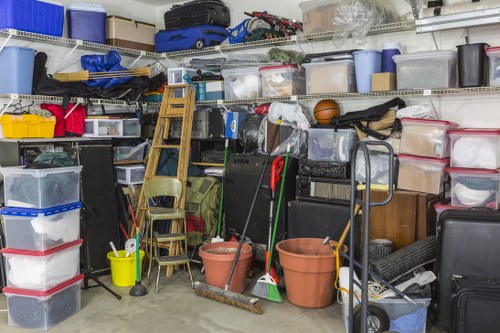Effective Construction Waste Disposal in Swiss Cottage

Construction projects in Swiss Cottage generate significant amounts of waste, necessitating efficient disposal methods to maintain the area's cleanliness and environmental standards. Proper waste management not only complies with local regulations but also promotes sustainability and reduces the carbon footprint of construction activities.
Understanding the types of construction waste is crucial for effective disposal. Common waste materials include concrete, wood, metals, plastics, and hazardous substances like asbestos. Each type requires specific handling to ensure safe and compliant disposal.
Implementing a comprehensive waste management plan at the onset of a construction project can streamline the disposal process, minimize costs, and enhance overall project efficiency. This plan should detail the types of waste generated, disposal methods, and timelines for waste removal.
Types of Construction Waste in Swiss Cottage

Construction waste varies widely, encompassing materials that are remnants of building activities. Identifying these materials is the first step toward effective disposal.
Concrete and Masonry: These materials are often recycled or repurposed due to their volume and weight. Recycling concrete not only saves landfill space but also reduces the need for new raw materials.
Wood Waste: Includes offcuts, pallets, and untreated lumber. Wood waste can be reused in other projects or processed into mulch or biomass fuel.
Regulations Governing Waste Disposal

Swiss Cottage adheres to specific regulations designed to manage construction waste effectively. These regulations ensure that waste disposal is conducted in an environmentally responsible manner.
The Environmental Protection Act outlines the guidelines for waste management, emphasizing the reduction, reuse, and recycling of construction materials. Adhering to these regulations helps avoid legal penalties and promotes community well-being.
Additionally, local authorities may have specific requirements regarding waste segregation and the use of licensed disposal facilities. It is essential to stay informed about these rules to ensure compliance throughout the construction process.
Waste Segregation Practices

Effective waste segregation is a cornerstone of sustainable construction waste management. By separating different types of waste at the source, it becomes easier to recycle and dispose of materials responsibly.
Implementing designated containers for various waste streams—such as recyclable materials, hazardous waste, and general refuse—can significantly enhance the segregation process. Training workers on proper segregation techniques is equally important to ensure consistency and efficiency.
Moreover, labeling containers clearly and providing guidelines can minimize contamination and maximize the potential for recycling and reuse.
Recycling and Reuse Strategies

Recycling and reusing construction waste not only conserves resources but also reduces disposal costs. Various strategies can be employed to maximize the recycling potential of construction materials.
Material Recovery: Extracting valuable materials like metals, glass, and certain plastics from construction waste can feed back into the supply chain, reducing the demand for virgin materials.
On-site Recycling: Processing certain materials on-site, such as crushing concrete for reuse in foundation work, can streamline the construction process and minimize waste transportation.
Choosing the Right Disposal Services
Partnering with reputable waste disposal services in Swiss Cottage ensures that construction waste is handled responsibly. These companies offer tailored solutions that align with your project's specific needs, from bulky material removal to hazardous waste management.
When selecting a disposal service, consider factors such as their licensing, recycling capabilities, and adherence to local regulations. A reliable partner will provide timely waste removal, reducing the risk of project delays and environmental impact.
Cost-Effective Solutions
Budget constraints are a common concern in construction projects. Effective waste disposal strategies can lead to significant cost savings by reducing the volume of waste, thereby lowering disposal fees. Additionally, recycling certain materials can create revenue streams, further offsetting project costs.
Environmental Impact
Proper waste disposal minimizes the environmental footprint of construction activities. By diverting waste from landfills and promoting recycling, construction projects contribute to a healthier ecosystem and support local sustainability initiatives.
- Reduces landfill usage
- Conserves natural resources
- Minimizes greenhouse gas emissions
- Promotes sustainable building practices
Innovative Waste Management Technologies

Advancements in waste management technologies are revolutionizing how construction waste is handled in Swiss Cottage. These innovations enhance efficiency, reduce costs, and improve environmental outcomes.
Automation: Automated sorting systems can quickly and accurately separate different types of waste, increasing recycling rates and reducing manual labor.
Waste Tracking Software: Digital tools help monitor waste generation and disposal, providing valuable data that can be used to optimize waste management strategies.
Community Involvement
Engaging the local community in waste disposal efforts fosters a collaborative approach to sustainability. Education programs and outreach initiatives can raise awareness about the importance of responsible waste management and encourage participation in recycling programs.
Community-driven projects, such as local recycling centers or waste collection events, can complement construction waste disposal efforts and contribute to the overall cleanliness and attractiveness of Swiss Cottage.
Future Trends
The future of construction waste disposal in Swiss Cottage is likely to be shaped by ongoing technological advancements and evolving regulatory frameworks. Embracing these changes early can position construction projects for long-term success and sustainability.
Green Building Certifications
Obtaining green building certifications, such as LEED or BREEAM, can demonstrate a commitment to sustainable waste management practices. These certifications often require stringent waste disposal protocols, encouraging projects to adopt the best available methods.
- Adopt sustainable construction materials
- Implement comprehensive waste management plans
- Utilize advanced recycling technologies
- Engage stakeholders in sustainability initiatives
Conclusion

Construction waste disposal in Swiss Cottage is a critical aspect of modern building practices. By understanding the types of waste, adhering to regulations, implementing effective segregation and recycling strategies, and leveraging innovative technologies, construction projects can achieve sustainable outcomes.
Collaborating with experienced waste disposal services and engaging the local community further enhances the effectiveness of waste management efforts. As the industry continues to evolve, staying informed about best practices and emerging trends will be essential for maintaining environmental standards and promoting sustainability.
Contact us today to learn more about how we can assist with your construction waste disposal needs in Swiss Cottage.